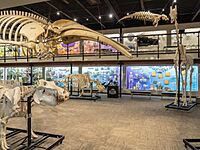Museum of Osteology facts for kids
 |
|

A look inside the museum in 2022
|
|
| Established | 2010 |
|---|---|
| Location | Oklahoma City, United States |
| Type | Natural history museum |
| Collection size | 7,000+ skeletal specimens |
| Visitors | 500,000+ |
| Owner | Jay Villemarette |
The Museum of Osteology is a special museum in Oklahoma City, USA, that is all about bones and skeletons. The study of bones is called osteology. Inside, you can see over 450 skeletons from different animal species found all over the world.
The museum actually has a collection of more than 7,000 skeletons. This makes it the largest private collection of its kind anywhere on Earth. The museum is part of a company called Skulls Unlimited International.
Contents
What You Can See and Do
The museum teaches visitors how the skeletal system works. The exhibits show how an animal's skeleton helps it move and survive. You can see skeletons from all five main groups of vertebrate animals: mammals, birds, reptiles, amphibians, and fish.
The huge collection was put together over 40 years by the museum's founder, Jay Villemarette. It includes about 7,000 skeletons from over 1,800 different types of animals. The museum also holds fun events for all ages. Visitors can even touch some of the bones and pose for pictures with complete skeletons.
Museum History
Jay Villemarette, who started the company Skulls Unlimited International, Inc., built the museum with his family. The offices for Skulls Unlimited are right next door. They started building the museum in 2004, and it opened on October 1, 2010.
Villemarette wanted to share his amazing collection with everyone. He hoped to make the science of osteology easier for people to understand and enjoy. In 2015, a second museum opened in Orlando, Florida. That location closed in 2020, and all the skeletons were brought back to the Oklahoma City museum.
Amazing Exhibits
The museum has many cool exhibits. You can see skeletons from every major animal group. There are also giant whale skeletons hanging from the ceiling.
All the skeletons are carefully cleaned next door at Skulls Unlimited. They use special insects called dermestid beetles to eat away all the tissue, leaving just the clean bones. Then, the skeletons are put together and placed in the museum.
The exhibits cover topics like how animals move and adapt to their environment. There are also displays about forensic osteology, which is how scientists study bones to solve crimes. The museum offers fun scavenger hunts for kids and families.
Where Do the Skeletons Come From?
The museum gets its skeletons from many places. It works with zoos, aquariums, and wildlife centers. It also receives donations from hunters and other private individuals. The museum also has human skeletons that were donated to science.
Skeletons You Have to See
- Humpback whale – This is one of only 12 complete humpback whale skeletons on display in North America. The whale washed up on a beach in 2003. It was buried for two years to decompose before being cleaned. The cleaning of this whale was shown on an episode of the TV show Dirty Jobs.
- Javan Rhino – This is the rarest skeleton in the entire museum. Javan rhinos are critically endangered.
- Whales and Dolphins – The museum has the largest private collection of skeletons from cetaceans. This group includes whales, dolphins, and porpoises. You can see skeletons from 46 different cetacean species here.


